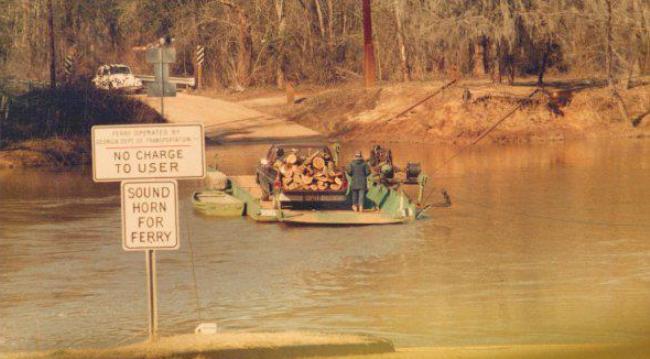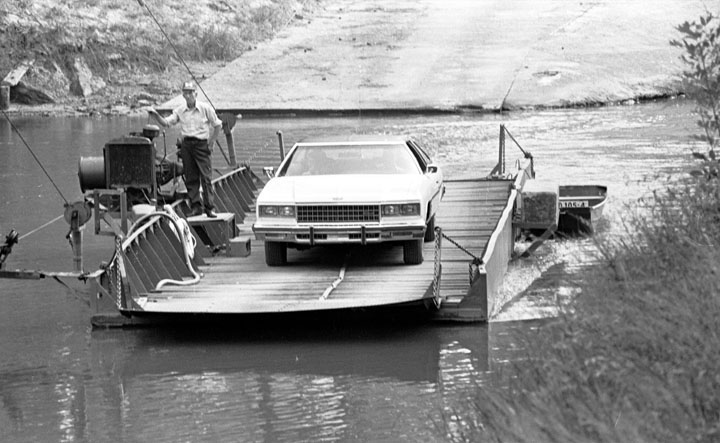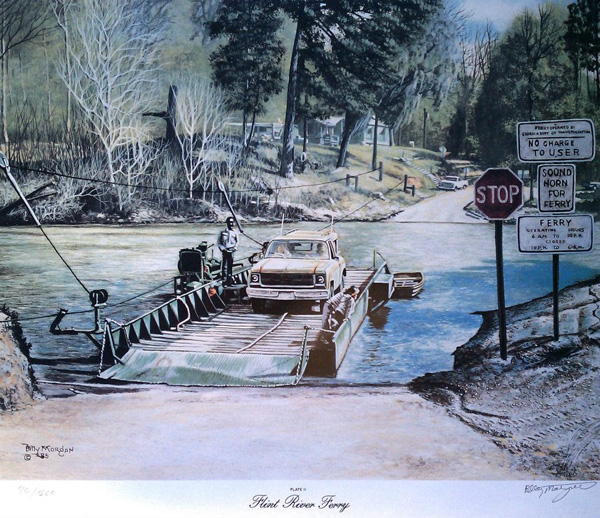 The Last Ferry on the Flint River
The Last Ferry on the Flint River
Settlers poured into western Georgia to farm the land between the Flint and Chattahoochee rivers in the early 19th century, often setting up large cotton plantations. In 1828 the Apalachicola-Chattahoochee-Flint river system began supporting steamboat travel.
By 1860 more than 26 steamboat landings dotted the Flint between Bainbridge and the river's junction with the Chattahoochee. Steamboats traveled upriver as far as Montezuma until the sandy, shifting riverbed of the Middle Flint proved too treacherous. Steamboats below Bainbridge continued to thrive and remained in operation until about 1928, mostly to ship cotton to the port of Apalachicola. Smaller boats and barges traveled from Bainbridge to Albany.
While steamboats navigated the Flint lengthwise, numerous ferries traversed the river. The last ferry across the Flint River, near Marshallville, closed in 1988. According to an article in Brown's Guide:
|
|
"Trails that led to the Flint always found their way to the shallowest point possible in order for travelers to ford the river. Initially, travelers crossed by walking or riding horses over the rocky shoals. The first ferries built were usually just logs tied together to form a raft-like vehicle that was often pulled by horses. Later most ferries were large wooden barges operated by a system of cables and pulleys and powered mainly by the river’s current, with additional encouragement from a long wooden pole in the hands of a muscular ferryman. Horses were sometimes used.
"How many ferries crossed the Flint is hard to determine, but there were plenty. In Macon County alone there were at least four ferries, at one time or another, crossing the Flint. The real heyday of ferries was in the 19th century, although some continued to operate well into the 20th century. In 1920, the Georgia Highway Department took over the state road system and the ferries on those roads were purchased from private individuals who had been operating them. Toll charges were abolished at state-owned ferries. One by on though, bridges replaced the ferries.
"The last ferry crossing in Georgia was on the Flint near Marshallville. At first, a wooden barge was used at the ferry, which was known over the years by various names, including the Miona Ferry, the Marshallville Ferry, Underwood’s Ferry and the Flint River Ferry. Later the craft in use was a 55-foot metal barge with a plank floor, powered by a six-cylinder 1954 Chevrolet engine rigged up to cables. The crossing was safe, smooth and only took a couple of minutes. Unless the river was extremely high or there were problems with snags and floating logs, 24-hour service was available until 1988 when the ferry discontinued service."
Ferries
Trails that led to the Flint always found their way to the shallowest point possible in order for travelers to ford the river. Initially, travelers crossed by walking or riding horses over the rocky shoals. The first ferries built were usually just logs tied together to form a raft-like vehicle that was often pulled by horses. Later most ferries were large wooden barges operated by a system of cables and pulleys and powered mainly by the river’s current, with additional encouragement from a long wooden pole in the hands of a muscular ferryman. Horses were sometimes used.
How many ferries crossed the Flint is hard to determine, but there were plenty. In Macon County alone there were at least four ferries, at one time or another, crossing the Flint. The real heyday of ferries was in the 19th century, although some continued to operate well into the 20th century. In 1920, the Georgia Highway Department took over the state road system and the ferries on those roads were purchased from private individuals who had been operating them. Toll charges were abolished at state-owned ferries. One by on though, bridges replaced the ferries.
The last ferry crossing in Georgia was on the Flint near Marshallville. At first, a wooden barge was used at the ferry, which was known over the years by various names, including the Miona Ferry, the Marshallville Ferry, Underwood’s Ferry and the Flint River Ferry. Later the craft in use was a 55-foot metal barge with a plank floor, powered by a six-cylinder 1954 Chevrolet engine rigged up to cables. The crossing was safe, smooth and only took a couple of minutes. Unless the river was extremely high or there were problems with snags and floating logs, 24-hour service was available until 1988 when the ferry discontinued service.
- See more at: http://www.brownsguides.com/blog/a-short-history-of-the-flint-river/#sthash.gHONvg53.dpuf
The Last Ferry on Facebook (source of photo on this page)



